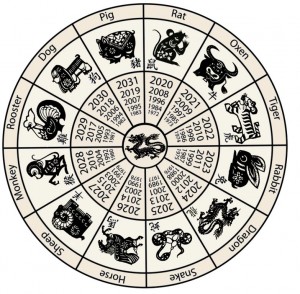Chinese Astrology
 Chinese astrology was elaborated during the Zhou dynasty (1046–256 BC) and flourished during the Han Dynasty (2nd century BC to 2nd century AD). During the Han period the familiar elements of traditional Chinese culture – the Yin-Yang philosophy, theory of the 5 elements, Heaven and Earth, Confucian morality – were brought together to formalize the philosophical principles of Chinese medicine and divination, astrology and alchemy.
Chinese astrology was elaborated during the Zhou dynasty (1046–256 BC) and flourished during the Han Dynasty (2nd century BC to 2nd century AD). During the Han period the familiar elements of traditional Chinese culture – the Yin-Yang philosophy, theory of the 5 elements, Heaven and Earth, Confucian morality – were brought together to formalize the philosophical principles of Chinese medicine and divination, astrology and alchemy.
The 5 classical planets are associated with the Wu Xing:
- Venus—Metal (White Tiger)
- Jupiter—Wood (Azure Dragon)
- Mercury—Water (Black Tortoise)
- Mars—Fire (Vermilion Bird)
- Saturn—Earth (Yellow Dragon)
According to Chinese astrology, a person’s destiny can be determined by the position of the major planets at the person’s birth along with the positions of the Sun, Moon and comets and the person’s time of birth and zodiac Sign. The system of the twelve-year cycle of animal signs was built from observations of the orbit of Jupiter (the Year Star; simplified Chinese: 岁星; traditional Chinese: 歳星; pinyin: Suìxīng). Following the orbit of Jupiter around the sun, Chinese astronomers divided the celestial circle into 12 sections, and rounded it to 12 years (from 11.86). Jupiter is associated with the constellation Sheti (simplified Chinese: 摄提; traditional Chinese: 攝提- Boötes) and is sometimes called Sheti.
A system of computing one’s fate and destiny based on one’s birthday, birth season, and birth hours, known as Zi Wei Dou Shu (simplified Chinese: 紫微斗数; traditional Chinese: 紫微斗數; pinyin: zǐwēidǒushù), or Purple Star Astrology, is still used regularly in modern day Chinese astrology to divine one’s fortune. The 28 Chinese constellations, Xiu (Chinese: 宿; pinyin: xìu), are quite different from Western constellations. For example, the Big Bear (Ursa Major) is known as Dou (Chinese: 斗; pinyin: dǒu); the belt of Orion is known as Shen (simplified Chinese: 参; traditional Chinese: 參; pinyin: shēn), or the “Happiness, Fortune, Longevity” trio of demigods. The seven northern constellations are referred to as Xuan Wu (Chinese: 玄武; pinyin: xúanwǔ). Xuan Wu is also known as the spirit of the northern sky or the spirit of Water in Taoism belief.
In addition to astrological readings of the heavenly bodies, the stars in the sky form the basis of many fairy tales. For example, the Summer Triangle is the trio of the cowherd (Altair), the weaving maiden fairy (Vega), and the “tai bai” fairy (Deneb). The two forbidden lovers were separated by the silvery river (the Milky Way). Each year on the seventh day of the seventh month in the Chinese calendar, the birds form a bridge across the Milky Way. The cowherd carries their two sons (the two stars on each side of Altair) across the bridge to reunite with their fairy mother. The tai bai fairy acts as the chaperone of these two immortal lovers.